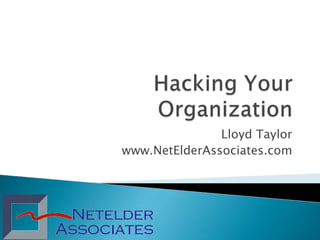
Lloyd Taylor: "Hacking Your Organization"
- 2. Culture as Operating System People as BIOS Departments as Tribes Putting it Together
- 3. A culture is a set of rules on how things are to be done. ◦ Some are explicit printf(); Coding Standards ◦ Most are implicit, and often hidden Social customs & dress Leaders of a group will tend to hide the rules as a way of reinforcing the group’s identity.
- 4. One way to map company culture is by identifying the levels of sociability and solidarity. ◦ Sociability: level of friendliness within group People relate to each other in a friendly, caring way ◦ Solidarity: level of focus on group goals Strong focus on joint effort to accomplish common goal
- 5. Sociability ◦ Positive: Fun place to work, supportive environment, socialize with coworkers ◦ Negative: Tolerate poor performance, slow decision making, cliques, hidden decisions Solidarity ◦ Positive: Clear goals and objectives, strong team spirit ◦ Negative: Repress individual needs, intolerant of those who don’t fit, poor work/life balance
- 6. Networked Communal High Sociability Fragmented Mercenary Low Low High Solidarity Source: The Character of a Corporation
- 7. Open plan & shared space, decorated with company-related stuff Lots of informal communication, often with private company language People live at work. Social group is work group Company attracts fierce loyalty Work identity defines private life
- 8. Offices/cubes decorated with personal items Lots of informal communication Social activities are common Lots of MBWA How you communicate is as important as what you communicate
- 9. Offices/cubes decorated with awards, certificates, degrees, photos of famous people Communication is direct, swift, and work- focused Long hours, little socialization Winning is everything Today’s ally is tomorrow’s enemy
- 10. Office doors closed – interruptions unwelcome Communication mostly 1:1. Few meetings Office is generally empty – people work outside Allegiance is professional, not organizational People work at the organization, but for themselves
- 11. Join the family Love the product Live the credo Follow the leader Fight the good fight Don’t worry about the competition
- 12. Make friends all over the organization Help others when they need it Rules are meant for interpreting Your career belongs to you
- 13. Personal life is subordinate to professional Work weekends Make things happen Destroy the competition – within and without Hit your targets Don’t over-think – act!
- 14. Make yourself valuable Keep your eyes on the prize – outside the company Honor ideas and outcomes, not individuals Hire brilliantly Show up occasionally Learn to manage prima-donnas
- 15. Ensure that Implicit and Explicit cultures are in sync ◦ Otherwise people will perceive and resent hypocrisy The Founders’ personalities largely define culture ◦ A mercenary founder is unlikely to create a communal culture Hire only leaders who will thrive in the selected culture
- 16. Small companies often start as Communal ◦ Intense communal effort to launch Communal Networked is common growth path ◦ Must maintain high sociability Communal Mercenary also possible ◦ Where results matter more than individuals Communal Fragmented when company suffers trauma (leader leaves, acquisition)
- 17. • People (and hardware) are complex • But there are ways to simplify the interface • We use abstractions to help hide complexity, and make things easier to work with • Abstractions are inherently false!
- 18. Why do we act as we do? What makes us who we are? Each of us act in our own perceived self-interest
- 19. When we observe the action of another ◦ we impute a motivation for that action ◦ and react emotionally to that imputed motivation. This Imputation process is the core of most conflict.
- 20. Incentive Conflict is when two people (or organizations) are striving to achieve mutually exclusive goals ◦ Classic example: Dev and Ops Understanding the implicit and explicit incentives of your co-workers is key. It’s critical to understand your own incentives as well
- 21. Groups of people always form tribes ◦ Can belong to multiple tribes. ◦ What tribes do you belong to? Each tribe has it’s own set of axiomatic beliefs, and will resist the beliefs of other tribes. Tribes behave in predictable ways as they get larger
- 22. Anthropologist Robin Dunbar developed model relating primate brain volume to number of individuals we can related to Humans rated roughly 150 ◦ But only with heavy ‘social grooming’ behavior Common cultural shift points at ~15, 50, and 150 employees ◦ 15 – Max number where each can keep track of what everyone else is doing ◦ 50 – Max number where each can be generally aware of what everyone else is doing ◦ 150 – Max number for even knowing each other
- 23. Diagnose the culture of your organization, department, team. Remember that leader’s style largely defines culture. ◦ Watch out for differences between stated culture and actual culture. Observe behaviors, not words. Diagnose your own motivations & incentives
- 24. Pick two or three people who most affect your job and diagnose their motivations & incentives Find ways to help them accomplish their desires Profit!